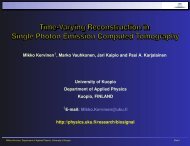USER'S GUIDE - Biosignal Analysis and Medical Imaging Group
USER'S GUIDE - Biosignal Analysis and Medical Imaging Group
USER'S GUIDE - Biosignal Analysis and Medical Imaging Group
- No tags were found...
You also want an ePaper? Increase the reach of your titles
YUMPU automatically turns print PDFs into web optimized ePapers that Google loves.
5.2. Sample run 2: Time-varying analysis 565.2 Sample run 2: Time-varying analysisIn the second sample run, we show how to make time-varying analysis for the whole orthostaticHRV measurement. First of all, we need to enable the time-varying analysis fromthe preferences. To do this select Edit preferences from the File menu <strong>and</strong> check the timevaryinganalysis from <strong>Analysis</strong> options category of the preferences window. If you do notwant to view any of the time-domain, frequency-domain, or nonlinear analysis results <strong>and</strong>nor do you wish to include any of them in the report sheets or results file, you should at thesame time uncheck the general analysis from the preferences. Then press the OK button,<strong>and</strong> the time-varying analysis will be enabled in the user interface.For the time-varying analysis we wish to include the whole measurement period <strong>and</strong>,thus, we set the Range of the RR interval sample to 0–737 seconds. This can be done usingthe Range edit boxes or by resizing the sample patch with the mouse. For the same reasonsas in the first sample run we use again the smoothness priors detrending method with theLambda value of 500.The time-varying analysis results can then be viewed in the results view segment (pressthe Time-varying button). The variable in view can be selected from the two pop up buttonson the lower left h<strong>and</strong> corner of the results view. For example, in Fig. 5.4 (a) the timedomainvariable pNN50 has been selected for view. All the time-domain variables as well asthe two nonlinear variables are calculated using a moving window the width <strong>and</strong> time shift ofwhich can be changed by editing the Window width <strong>and</strong> Grid interval values. Here we haveused a 60 second window <strong>and</strong> a 10 second grid interval. The frequency-domain variables,on the other h<strong>and</strong>, are obtained from the time-varying spectrum estimate for which thereare two different methods available. These are the spectrogram <strong>and</strong> the Kalman smoothermethods. The spectrogram method is simply a moving window Fourier transformationmethod. The same moving window settings used for time-domain <strong>and</strong> nonlinear variablesare also utilized for the spectrogram. The Kalman smoother method, on the other h<strong>and</strong>, isbased on time-varying AR modeling <strong>and</strong> does not utilize the same kind of moving windowas the spectrogram. Thus, the window width value does not apply to the frequency-domainvariables if the Kalman smoother is used for spectrum estimation. The Grid interval is,however, utilized for the Kalman smoother method as well.The differences between the spectrogram <strong>and</strong> Kalman smoother methods have beendiscussed in [42], where they were applied to nonstationary EEG signals. In brief, it can besaid that the Kalman smoother is computationally more complex but yields better resolutionthan the spectrogram. The spectrogram is also more robust <strong>and</strong> requires only the movingwindow settings to be defined. The Kalman smoother methods, on the other h<strong>and</strong>, requiresthe fixing of both the adaptation coefficient <strong>and</strong> the AR mode order. Spectrogram <strong>and</strong>Kalman smoother spectrum estimates for the orthostatic measurement are presented inFigs. 5.4 (b) <strong>and</strong> (c). The adaptation coefficient of the Kalman smoother method was setto 0.1 <strong>and</strong> the AR model order to 16.The results of the time-varying analysis can be saved as in the first sample run. If thegeneral analysis was disabled from the preferences window, only time-varying results willbe included in the PDF <strong>and</strong> ASCII text files. In the PDF-file the time-varying results arepresented in one page shown in Fig. 5.5.Kubios HRV <strong>Analysis</strong>version 2.0 beta<strong>Biosignal</strong> <strong>Analysis</strong> <strong>and</strong> <strong>Medical</strong> <strong>Imaging</strong> <strong>Group</strong>Department of PhysicsUniversity of Kuopio, FINLAND





